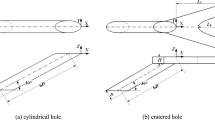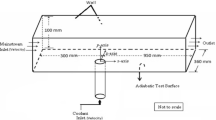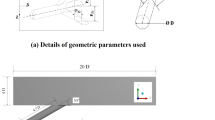Abstract
In order to investigate the flow characteristics and film cooling performance of novel merged holes cooling method, merged cylindrical holes structures have been applied on a flat plate with three merging ratios under three blowing ratios. Single cylindrical hole film cooling structure is also established as a benchmark structure. The numerical results of the single cylindrical hole are validated with the experimental results available in open literatures. The discharge coefficient, aerodynamic loss, tangential velocity vectors and total vorticity distributions are studied and compared. The spanwise averaged film cooling effectiveness and adiabatic temperature contours are studied and compared. Results show that the development of the kidney vortex is impeded and the film cooling performance is promoted in merged holes cooling cases. The blowing ratio and merging ratio both affect the cooling performance of merged holes cooling cases. In this paper, the best film cooling performance is obtained at the biggest merging ratio.













Similar content being viewed by others
Abbreviations
- A h :
-
cross section area of one film cooling hole (m2)
- C d :
-
discharge coefficient of film cooling hole
- D:
-
diameter of cylindrical jet hole (m)
- DMH :
-
diameter of each circle of the merged holes structure (m)
- M :
-
blowing ratio
- ṁ :
-
mass flow rate (kg·s−1)
- m h :
-
cooling air mass flow rate through one film cooling hole (kg·s−1)
- P :
-
static pressure (Pa)
- P e :
-
static pressure at the film cooling hole exit (Pa)
- P te :
-
total pressure at the film cooling hole outlet (Pa)
- P tmain :
-
total pressure at the mainstream inlet (Pa)
- P tc :
-
total pressure at the film cooling hole inlet (Pa)
- S :
-
distance between two merged cylindrical holes (m)
- T :
-
temperature (K)
- T tc :
-
total temperature at the film cooling hole inlet (K)
- Tu :
-
turbulent intensity
- TV :
-
total vorticity
- U :
-
velocity (m·s−1)
- u :
-
velocity along x direction (m·s−1)
- v :
-
velocity along y direction (m·s−1)
- w :
-
velocity along z direction (m·s−1)
- x :
-
coordinate along the chamber axial direction (m)
- y :
-
coordinate along the jet hole axial direction (m)
- y + :
-
non-dimensional wall distance
- z :
-
coordinate along the direction normal to both the x and y directions (m)
- β :
-
merging ratio of the merged holes structure
- θ :
-
film cooling hole inclination angle (°)
- η :
-
film cooling effectiveness
- \( \overline{\eta} \) :
-
span averaged film cooling effectiveness
- Δη :
-
span averaged film cooling effectiveness enhancement in merged holes cooling cases
- μ :
-
dynamic viscosity (Pa·s−1)
- ρ :
-
density (kg·m−3)
- aw:
-
adiabatic wall
- c:
-
coolant
- h:
-
one film cooling hole
- in:
-
inlet
- main:
-
mainstream air
- out:
-
mainstream channel outlet
- overall:
-
overall averaged parameter of the flat plate surface
- t:
-
parameter with total value
References
Andreopoulos J, Rodi W (1984) Experimental investigation of jets in a crossflow. J Fluid Mech 138:93–127
Gogineni SP, Rivir RB, Pestian DJ, Goss LP (1996) PIV measurements of flat plate film cooling flows with high free stream turbulence. AIAA paper 96:0617
Goldstein RJ, Eckert ERG, Burggraf F (1974) Effects of hole geometry and density on three-dimensional film cooling. Int J Heat Mass Transf 17:595–607
Thole K, Gritsch M, Schulz A, Wittig S Flowfield measurements for film-cooling holes with expanded exits, ASME Paper 96-GT-174
Haven BA, Yamagata DK, Kurosaka M, Yamawaki S, Maya T Anti-kidney pair of vortices in shaped holes and their influence on film cooling effectiveness, ASME Paper 97-GT-045
Bunker RS Film cooling effectiveness due to discrete holes within a transverse surface slot. ASME Paper GT2002–30178
Yang X, Liu Z, Feng ZP (2015) Numerical evaluation of novel shaped holes for enhancing film cooling performance. Journal of Heat Transfer transactions of the ASME 137(7):071701
Bunker RS (2005) A review of shaped hole turbine film-cooling technology. J Heat Transf 127:441–453
Wei JS, Zhu HR, Liu CL, Song H, Liu C, Meng T Experimental study on the film cooling characteristics of the cylindrical holes embedded in sine-wave shaped trench. ASME Paper GT2016–56856
Kalghatgi P, Acharya S (2015) Improved film cooling effectiveness with a round film cooling hole embedded in a contoured crater. J Turbomach 137(10):101006
Sargison JE, Guo SM, Oldfield MLG, Lock G, Rawlinson AJ (2002) A converging slot-hole film-cooling geometry—part 1: low-speed flat-plate heat transfer and loss. J Turbomach 124:453–460
Sargison JE, Guo SM, Oldfield MLG, Lock G, Rawlinson AJ (2002) A converging slot-hole film-cooling geometry—part 2: transonic nozzle guide vane heat transfer and loss. J Turbomach 124:461–471
Javadi A, Javadi K, Taeibi-Rahni M, Darbandi M (2003) A new approach to improve film cooling effectiveness using combined jets. Momentum 2:2
Javadi K, Taeibi-Rahni M, Darbandi M (2007) Jet-into-crossflow boundary-layer control: innovation in gas turbine blade cooling. AIAA J 45(12):2910
Al-Zurfi N, Turan A, Nasser A (2016) Numerical investigation of rotation effects on anti-vortex film-cooling holes. Flow, Turbulence and Combustion 96(1):133–162
Heidmann JD, Ekkad S (2008) A novel antivortex turbine film-cooling hole concept. J Turbomach 130(3):031020
Dhungel A, Lu Y, Phillips W, Ekkad SV, Heidmann J (2009) Film cooling from a row of holes supplemented with antivortex holes. J Turbomach 131(2):021007
Soe MKK, Ting DS, Hong W (2011) Analysis of film cooling effectiveness on antivortex hole. in: 2011 international conference on consumer electronics, communications and networks, IEEE, 4763–4766
Ely MJ, Jubran BA (2009) A numerical study on improving large angle film cooling performance through the use of sister holes. Numerical Heat Transfer, Part A: Applications 55(7):634–653
Ely MJ, Jubran B (2009) A numerical evaluation on the effect of sister holes on film cooling effectiveness and the surrounding flow field. Heat Mass Transf 45:1435–1446
Ely MJ, Jubran B (2010) A parametric study on the effect of sister hole location on active film cooling flow control. in: ASME Turbo expo 2010: power for land, sea, and air, ASME, 1301–1311
Ely MJ, Jubran B (2012) Film cooling from short holes with sister hole influence. in: ASME Turbo expo 2012: turbine technical conference and exposition, ASME, 1185–1196
Khajehhasani S, Jubran BA Film cooling from circular and elliptical exit shaped holes with sister hole influence. ASME Paper GT2013–95138
Khajehhasani S, Jubran B Film cooling from novel sister shaped single-holes. ASME Paper GT2014-25971
Khajehhasani S, Jubran BA (2015) Numerical assessment of the film cooling through novel sister-shaped single-hole schemes. Numerical Heat Transfer, Part A: Applications 67(4):414–435
Wu H, Cheng H, Li Y, Rong C, Ding S (2016) Effects of side hole position and blowing ratio on sister hole film cooling performance in a flat plate. Appl Therm Eng 93:718–730
Sun X, Zhao G, Jiang P, Peng W, Wang J (2017) Influence of hole geometry on film cooling effectiveness for a constant exit flow area. Appl Therm Eng 130:1404–1415
Gritsch M, Schulz A, Wittig S Discharge coefficient measurements of film-cooling holes with expanded exits. ASME Paper 97-GT-165
Colban W, Gratton A, Thole KA, Haendler M (2006) Heat transfer and film-cooling measurements on a Stator vane with fan-shaped cooling holes. J Turbomach 128(1):299–309
Author information
Authors and Affiliations
Corresponding authors
Ethics declarations
Conflict of interest
On behalf of all authors, the corresponding author states that there is no conflict of interest.
Additional information
Publisher’s note
Springer Nature remains neutral with regard to jurisdictional claims in published maps and institutional affiliations.
Rights and permissions
About this article
Cite this article
Zhou, J., Wang, X., Li, J. et al. Numerical investigation on the flow character and film cooling performance of novel merged holes structure. Heat Mass Transfer 55, 3575–3587 (2019). https://doi.org/10.1007/s00231-019-02684-0
Received:
Accepted:
Published:
Issue Date:
DOI: https://doi.org/10.1007/s00231-019-02684-0




